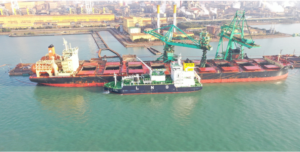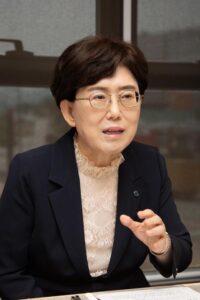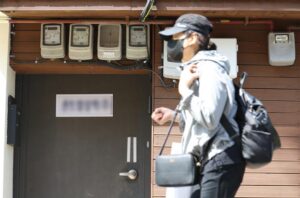South Korea’s Net Zero Delayed by its LNG Development & Expansion
Despite recent government pledges the impetus for more renewable energy has slowed considerably. Fossil fuels continue to monopolise Seoul’s power generation mix at some 63 % with LNG accounting for 27 % in the year 2022 and 26 % in the year 2023. South Korea presently has 7 LNG import terminals with a combined regasification capacity of around 153 mt per annum in addition to some 6.3 mt of LNG storage.
Korea Pioneer in LNG Bunkering
South Korea possesses world-class shipbuilding capabilities for LNG carriers and bunkering vessels. Due to safety concerns simultaneous operations of ship-to-ship LNG bunkering was carried out for the first time in the year 2023 for a coal-carrying bulk carrier at the POSCO raw material dock at one of the loading docks at Gwanyang Port. The Ministry of Oceans and Fisheries of Korea initiated a plan this year to promote LNG bunkering operations, support R&D projects and LNG bunkering operators by providing port facility fee discounts with the aim of ensuring the successful implementation of simultaneous LNG bunkering operations including the development of standard LNG bunkering operating procedures. The Ministry of Oceans and Fisheries of Korea is all set to expand the demonstration of bunkering with alternative marine fuels such as LNG and methanol at major Korean ports including the Port of Busan.
 Credit ; KR and OFFSHORE ENERGY
Credit ; KR and OFFSHORE ENERGY
Vicious Debt Cycle
Energy and power markets in South Korea are under increasing pressure as its largest electricity producer and supplier Korea Electric Power Corporation (KEPCO) continues to incur debt to cover financial loses arising to some extent from excessive reliance on imported LNG price hikes. A fresh Institute for Energy Economics and Financial Analysis (IEEFA) analysis revealed that South Korea’s LNG and fossil fuels usage for its power sector distorted domestic market prices for electricity.
South Korea has a population of 52 million people yet remains the world’s third largest LNG importer and as far back as the year 2022 it imported 46.4 million tonnes (mt) of LNG signifying the highest volume of the super-chilled fuel imported into the country in a decade. The IEEFA report disclosed that Seoul’s LNG intensive fossil-fuels usage burdened the country with an additional US $17 billion in electricity costs in 2022. The escalation in electricity prices is attributed to its fossil fuel-intensive energy security, lack of competitiveness and the country’s delayed energy transition to ” Net Zero “.
LNG price dynamics
The report also identified LNG price hikes in 2022 as a major cause for South Korea’s energy sector woes. Spot LNG prices touched a record $70.50 per million British thermal units (MMBtu) in 2022 but have fallen to a price of around $9/MMBtu. This price volatility is explained as being a crucial determinant of the country’s wholesale electricity market system on account of the significantly high amount of LNG in the power mix. The high share of LNG in the power mix escalates electricity tariffs. Combined with soaring wholesale power prices and at the same time retaining artificially low retail electricity tariffs in the midst of the Ukraine-Russian crisis has had an adverse financial impact on KEPCO’s financial stability leading to significant debt accumulation.
Debt Ridden utility
Korea Electric Power Corporation holds a unique position in South Korea’s energy sector as it has a virtual monopoly over power generation and distribution. The government and a state-controlled bank combined hold more than 50 % of shareholding of the electricity utility. The balance of the shares are traded on the New York and Korean Stock exchanges. The government perhaps sought to counter the inflationary impact of the global energy crisis by maintaining low end-user power tariffs which ultimately compelled the power utility to sell electricity to consumers at huge losses thereby aggravating KEPCO’s financial woes.These reoccurring losses were attempted to be managed by issuance of more bonds ,implicitly backed by the government, resulting in government deficits the financial burden of which may reverberate in the future. The powers utility’s CEO, Kim Dong-cheol informed that that fresh electricity rate hikes of around 40 % were insufficient for the utility to handle its mounting debts worth hundreds of billions of dollars.On the socio economic plane KEPCO slashed nearly 2,000 jobs at its corporate headquarters which is almost 20 % of its strength. There are expected to be repercussions for South Korea’s most integral sectors and industries like semiconductors, automobile manufacturing and exports, steel and petrochemicals which are energy intensive.
 Courtesy ; The Korea Times
Courtesy ; The Korea Times
Such an economic contagion could also dent Seoul’s ambition to lead the world in cutting-edge technology, artificial intelligence, carbon reduction and a clean energy transition as these sectors require energy intensity and major infrastructure investments.
Access to Imported LNG Price breakdown
It is the domain of the Ministry of Trade for setting energy prices in South Korea which pursues a policy of maintaining reduced electricity prices for supporting its manufacturing companies and keeping the sectors internationally competitive for its products and services.Whether simple raising of electricity rates to fair market prices and buying cheaper gas feedstock will resolve the debt issue is debatable as another nightmare for KEPCO is its LNG procurement policy wherein it is compelled to purchase the super-chilled fuel from state-owned Korea Gas Corporation (Kogas) which possesses a monopoly over gas sales in the country. Allegations abound that Kogas is covering its incompetence by not allowing the public to access the imported LNG price breakdown. The Kogas officials appear clueless as how to take advantage of having an inherent advantage as one of the world’s largest commercial LNG buyer in order to reduce the imported price. The outreach of Kogas is demonstrated in its participation in Mozambique’s $7 billion gas and LNG development project.
 Courtesy ; The Korea Times
Courtesy ; The Korea Times
Author : Nadir Mumtaz
Source/Credit ;
https://ieefa.org/articles/south-korea-building-too-many-lng-import-and-storage-terminals
https://eng.skgas.co.kr/Business/lng_terminal.html
https://www.koreatimes.co.kr/www/nation/2024/05/113_374760.html
https://www.koreatimes.co.kr/www/tech/2024/05/129_375139.html

Leave A Comment